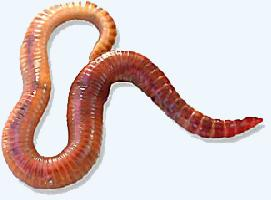
Popis zvířete
The manure worm, scientifically known as Eisenia fetida, is a species of earthworm commonly found in temperate climates across the world. It is particularly renowned for its role in the process of vermicomposting, where it is used to decompose organic waste materials into nutrient-rich compost. This worm is also colloquially referred to as the red wiggler, brandling worm, or tiger worm due to its distinctive physical appearance and patterns.Eisenia fetida typically measures about 2 to 3 inches in length, although it can grow up to 4 inches in optimal conditions. Its body is segmented, cylindrical, and possesses a reddish-brown color, often with distinctive yellowish or orange bands, which gives it a striped appearance reminiscent of a tiger's coat. This coloration can vary slightly depending on the worm's diet, age, and environmental conditions. The skin of the manure worm is moist to the touch, a necessity for its respiration, as it breathes through its skin.
One of the most fascinating aspects of Eisenia fetida is its reproductive system. These worms are hermaphrodites, meaning each individual possesses both male and female reproductive organs. However, they cannot self-fertilize and require a mate to reproduce. The mating process involves two worms exchanging sperm before each worm forms a cocoon, which will later hatch into several juvenile worms. The offspring are genetically distinct from their parents, promoting genetic diversity within the population.
Eisenia fetida thrives in environments rich in organic matter, such as compost piles, manure heaps, and decaying plant material. They are surface dwellers and rarely burrow deep into the soil, preferring moist conditions but not waterlogged environments, as excessive moisture can be detrimental to their survival. These worms are voracious feeders, capable of consuming their body weight in organic matter each day. As they feed, they pass the organic material through their digestive system, excreting it as castings, which are highly valued as a natural fertilizer due to their rich nutrient content and beneficial microorganisms.
The ecological role of the manure worm extends beyond just composting and soil enrichment. They are an integral part of the food web, serving as a food source for a variety of birds, small mammals, and other invertebrates. Moreover, their burrowing and feeding activities help to aerate the soil, improving its structure and enhancing water retention, which can be beneficial for plant growth.
Eisenia fetida has also become a subject of scientific interest and environmental education. Due to their efficiency in recycling organic waste, these worms are increasingly used in sustainable agriculture practices, waste management, and as a tool for teaching about ecosystems and recycling.
In summary, the manure worm, Eisenia fetida, is a small but mighty creature that plays a crucial role in soil health, waste decomposition, and sustainable agriculture. Its unique characteristics and ecological benefits make it an invaluable asset in efforts to promote environmental sustainability and organic farming practices
Nové fotografie zvířat
Top 10 zvířat
- Chinese water dragon (Physignathus cocincinus)
- Galápagos tortoise (Geochelone nigra complex)
- Dolphin gull (Leucophaeus scoresbii)
- Japanese macaque (Macaca fuscata)
- Colombian red howler (Alouatta seniculus)
- Sea urchins (Echinoidea)
- Moustached guenon (Cercopithecus cephus)
- Diana monkey (Cercopithecus diana)
- Common reed warbler (Acrocephalus scirpaceus)
- Common house mosquito (Culex pipiens)